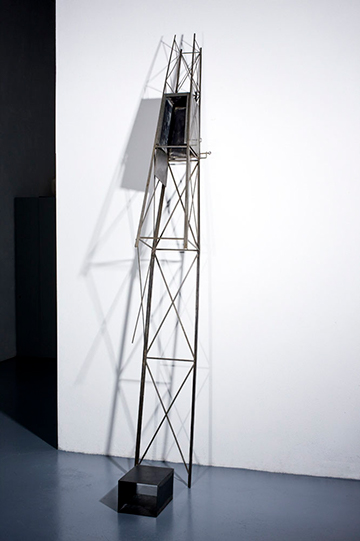Made by Jacobo Castellano between 2004 and 2005, Casa is one of the artist’s first sculptural pieces. Based on his grandparent’s now abandoned house in a village in Jaen
Collection
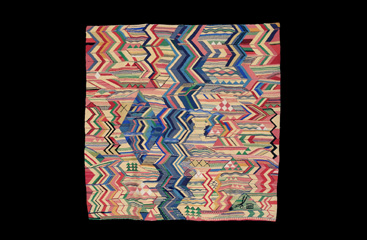
Lanceta defends the importance of weaving techniques and advocates placing weaving on a par with painting and sculpture. She argues that the “peripheral position of fabrics is not just metaphorical, but a reality, because societies that still weave are also peripheral
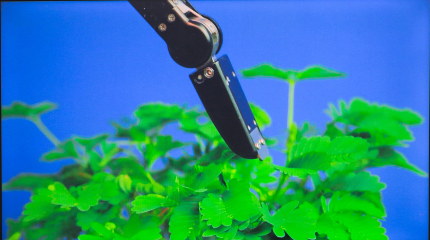
On view in the museum lobby, The Pudic Relation Between Machine and Plant, 2016, a piece by the New York based Portuguese artist Pedro Neves Marques (Lisbon, 1984), consists of a video made with the King’s College Centre for Robotics Research in which a sensitive plant, a Mimosa Pudica, reacts in contact with a robotic arm, closing every time the cyborg limb touches it.
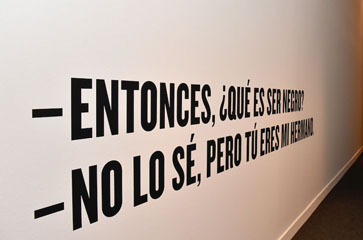
Y tú, ¿por qué eres negro? (And you, why are you black?) is an open, personal and collective archive of the construction of Blackness as a political force in Spain which can be approached in many ways. It is a dispositif to construct a history of our own but also an educational tool aimed at racialised audiences and an instrument of empowerment placing Afro- at the centre.

To celebrate International Museum Day, CA2M has come up with a new way of activating its collection and making it more widely accessible.
“ASSOCIATED MAKING. ASSEMBLY KIT OF PIECES FROM THE CA2M COLLECTION” is a curatorial programme by Marta Ramos-Yzquierdo that views the exhibition as an open, imaginative and surprising reflection in which artists, institutions and audiences can collectively rethink our contemporaneity.
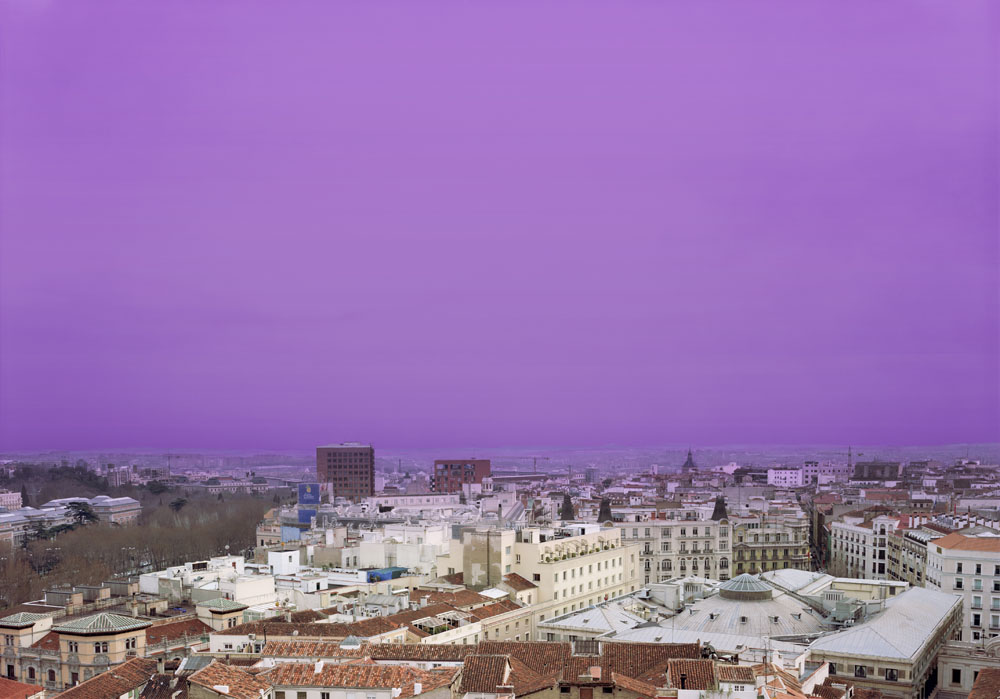
There is a signature feature to Hannah Collins’s photos of urban horizons: the sky is always tinted with a strange colour. Like the images over the credits of an imaginary film, this photo captures the feeling that a particular place—whether through premeditated cultural references or a subjective impression—produced in the artist at a certain point in time.
REASON FOR INTERVENTION
The decision to restore this work was taken following an application for the loan of the work received from Centre Pompidou in Paris for the retrospective exhibition CHRISTIAN BOLTANSKI. FAIRE SON TEMPS (13 November 2019 - 16 March 2020). The installation comprises a total of 360 elements in different materials and formats. The primary reason for this intervention was the notable deterioration produced by the corrosion of the metallic elements of the work. The very thin tinplate used for the boxes had reacted to the humidity, giving rise to corrosion which also affected the contents inside the boxes.
STATE OF CONSERVATION
The state of conservation of the work is below optimum both from an aesthetic as well as a structural viewpoint due to the advance state of oxidation of the boxes. The elements in the installation are as follows:
336 metal boxes
Affected by active oxidation, remains of adhesive, small shards of metal, stains, erosion, deformations and surface dirt.
The materials contained inside the boxes:
_ Fabric: the corrosion of the boxes has affected the inside and impregnated the fabrics and stained them with rust. Abundant dirt, deformations, breakages, signs of decomposition and bio-deterioration.
_ Cellulose support: general dirt, stains produced by damp and corrosion of metal. Oxidation of the material, yellowing, acidity, fragility. Biological contamination. Damage caused by incorrect storage such as deformation, creases, folds, breakage, small losses, exfoliation of corners. Traces of different kinds of adhesive tape, namely: sellotape, masking tape, gummed paper. Alterations of dyes: fading, colour bleeding.
_ Photographs: exfoliation in corners. Folds and creases. Corrugation, deformations, abrasions, inscriptions and stains.
12 boxes with photos with metal mesh
Montage of black and white photographs adhered to cardboard with adhesive, in turn adhered inside the box at six points with double-sided tape.
Dust and dirt had accumulated on the photographs as well as the boxes and metal mesh. The meshes and the boxes have active points of oxidation and some meshes have small breakages, erosion, deformations and traces of adhesive tapes. The wires holding the meshes are oxidized with some loss or breakage.
12 flexo-type lamps
Defective wiring, erosion caused by handling, small loss of paint, traces of adhesives, and general dirt.
TREATMENT UNDERTAKEN
Description of the different processes according to material:
Metal
Hand cleaning of all the boxes using steel wool of varying grades depending on the layer to be removed (000 and 0000), and a mixture of acetic acid (70%) with linseed oil (10%) and 96º alcohol (20%).
Brass brushes were used in areas with greater amounts of rust.
The remains of labels were removed with cotton swabs and 100% acetone dissolvent, and then finished mechanically with scalpels.
Treatment to protect the boxes in order to prevent oxidation with a mixture of 2% Paraloid B72 resin in acetone applied by brush.
Revision of system for mounting the 12 metallic meshes. Removal of rusted wires and replacement by stainless steel wires.
Fabric
Gentle micro-vacuuming and application of a biocidal treatment in spray: biotin in distilled water (1/3).
Followed by immersion in a mixture of 50% sodium bicarbonate and citric acid in distilled water, and the application of a specific reductive bleaching agent with final rinsing. Drying with driers and weights.
Cellulose support
Surface cleaning with Japanese brushes, elimination of deformations, damp control and weights, tears sutured with methyl-cellulose and Japanese paper. Dry cleaning with make-up sponges and isolated treatment of stains.
Photographs
Gentle vacuuming and Japanese brushes.
Flexo lamps
Surface cleaning, placement of clamps and replacement of bulbs with LEDs.
Preventive conservation rules applied, coding of all pieces and creation of new more appropriate packaging.
Finally, authorization and acceptance on behalf of the artist was sought at all times for the intervention undertaken, agreeing on the maintenance or conservation of the original aesthetic appearance and a respect for the material integrity of the work.
The decision to restore this work was taken following an application for the loan of the work received from Centre Pompidou in Paris for the retrospective exhibition CHRISTIAN BOLTANSKI. FAIRE SON TEMPS (13 November 2019 - 16 March 2020). The installation comprises a total of 360 elements in different materials and formats.
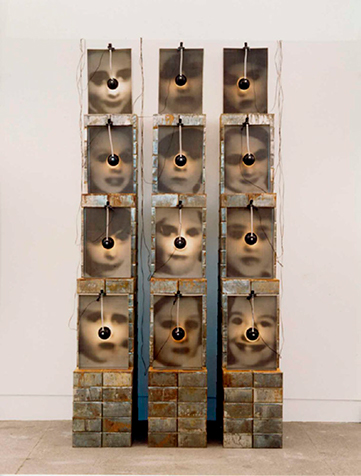
REASON FOR INTERVENTION
The decision to restore this work was taken following an application for the loan of the work for Diccionario incompleto de la fotografía española. CA2M Collection, an upcoming exhibition at Centro Oscar Niemeyer in Avilés and the poor state of conservation of the photocollage.
STATE OF CONSERVATION
This piece is in the middle of the process of restoration, currently interrupted due to the state of emergency.
The montage of the photocollage was being changed due to the inadequate materials for a correct conservation of the work, given that the back of the MDF board and the adhesives used to support the work were transmitting acidity to the original elements.
TREATMENT UNDERTAKEN
After first dismounting the work, we proceeded to eliminate all elements harmful for its correct conservation, although it was impossible to remove the cardboard on which the photos were adhered, as this was the original montage by the artist.
Remains of adhesive from sellotape and double-sided tape were removed with the aid of a hot air gun and various kinds of erasers.
Afterwards the front surface of the photographs was cleaned, eliminating fingerprints and any remains of adhesive as far as possible.
The work was then mounted again, adhering the photos lightly and fixing the work as a whole to a passe-partout folder with strips of Japanese paper.
The decision to restore this work was taken following an application for the loan of the work for Diccionario incompleto de la fotografía española. CA2M Collection, an upcoming exhibition at Centro Oscar Niemeyer in Avilés and the poor state of conservation of the photocollage.
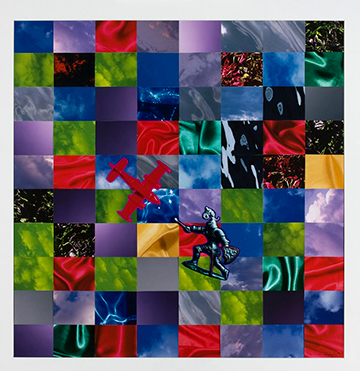
REASON FOR INTERVENTION
The installation consists of a mural, comprising four fragments, made by Manuel S. Molezún in 1958, and recovered by Patricia Esquivias in 2016. Located in one of the balconies intervened by Manuel S. Molezún in a building on Paseo de la Castellana in Madrid, it was removed and donated to CA2M by the artist, which was the reason for the intervention.
STATE OF CONSERVATION
Following an organoleptic examination of the pieces, it was ascertained that the state of conservation was less then optimum.
Both the support (brick and cement) as well as the ceramic tiles had deteriorated due to the location of the work outdoors, in contact with pollution and changing weather conditions like rain, wind and contrasts of heat and cold.
Once the mural was removed, with the tiles having been previously fixed with adhesive tape to avoid any of them falling off, part of the cement mortar was disaggregated which deteriorated the adhesiveness between it and the tiles and affected the visibility and integrity of the work.
TREATMENT UNDERTAKEN
The restoration was started with a process of surface cleaning where possible.
The consolidation of the support, the mural, and the fixation or adhesion of the tiles together with the elimination of the adhesives used during the phase of removal were the most delicate tasks.
Afterwards, the volumetric and chromatic reintegration of the tiles was undertaken.
As the final phase of the intervention, grout was added to recover the work’s original aesthetic and then finally a layer of protection was applied.
The installation consists of a mural, comprising four fragments, made by Manuel S. Molezún in 1958, and recovered by Patricia Esquivias in 2016. Located in one of the balconies intervened by Manuel S. Molezún in a building on Paseo de la Castellana in Madrid, it was removed and donated to CA2M by the artist, which was the reason for the intervention.
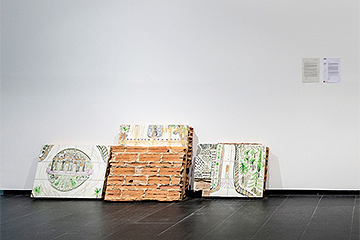
REASON FOR INTERVENTION
The sculpture under study is a metallic structure redolent of a truncated asymmetrical elevator.
The major concern was the deterioration of the asymmetrical structure caused primarily by its design, dimensions and the interplay of the different volumes and weights. This is further accentuated by the exhibition system, with its oblique inclination with respect to the wall and the fact that there are only two points of contact on which the work is supported.
STATE OF CONSERVATION
Some structural damage was observed in terms of deformation and damage to the material as well as active points of oxidation. The work was also affected by superficial damage in terms of accumulated dirt, environmental pollution, alteration of the layers of protection with whitish wax residues, losses, knocks and erosion.
TREATMENT UNDERTAKEN
After an initial cleaning of the whole sculpture, the deformations of the cross bracing were remedied.
Loose pieces were affixed with cold-welding using epoxy resins.
To strengthen the structure and provide the sculpture with greater stability, the system of anchoring the work was replaced and reinforced.
The treatment was concluded with the application of a final layer of protection.
The sculpture under study is a metallic structure redolent of a truncated asymmetrical elevator.
